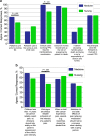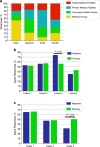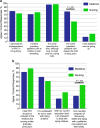New Directions in Pediatric Palliative Care Education for Preclinical Medical and Nursing Students
- PMID: 34457688
- PMCID: PMC8368940
- DOI: 10.1007/s40670-020-00928-x
New Directions in Pediatric Palliative Care Education for Preclinical Medical and Nursing Students
Abstract
Objectives: Since insufficient education has partially contributed to challenges in providing pediatric palliative care (PPC), a cross-sectional questionnaire study was conducted to explore the knowledge, attitudes, and educational needs of preclinical medical and nursing students in Hong Kong.
Methods: Pretested self-administered 44-item questionnaires with written informed consent were distributed to 241 medical and nursing students at Li Ka Shing Faculty of Medicine, the University of Hong Kong, between February and March 2019. This questionnaire covered eleven categories related to participants' knowledge of and attitudes towards PPC. A convenience sampling method was used. Data analysis was performed with descriptive statistics, chi-squared, and Fisher's exact test.
Results: Only 38.3% of participants had heard of PPC before, but 73.5% advocated for its local commencement. A large number, with more in nursing, misunderstood fundamental palliative concepts and pain assessment methods. Many reported that undergraduate curricula should include PPC since they were not prepared to deal and cope with dying children. More medical students identified multidisciplinary approaches in PPC while less believed that they were mentally prepared to discuss death and dying. The majority indicated family as the final decision maker, even for teenage patients. Although a large proportion agreed that PPC should be delivered at home since the diagnosis of a life-limiting illness, only a few were aware of the suggested referral structure.
Conclusions: Most healthcare students were supportive of PPC despite their limited exposure. PPC education on palliative principles, pain management, multidisciplinary approaches, and emotional coping skills is needed and welcomed among students.
Keywords: Interprofessional; Medical education; Medical education research; Nursing education; Pediatric palliative care; Undergraduate.
© International Association of Medical Science Educators 2020.
Conflict of interest statement
Conflict of InterestThe authors declare that they have no conflict of interest.
Figures




Similar articles
-
Undergraduate nursing students' knowledge about palliative care and attitudes towards end-of-life care: A three-cohort, cross-sectional survey.Nurse Educ Today. 2019 Mar;74:7-14. doi: 10.1016/j.nedt.2018.11.025. Epub 2018 Dec 7. Nurse Educ Today. 2019. PMID: 30554033
-
A study investigating the need and impact of pediatric palliative care education on undergraduate medical students in Japan.J Palliat Med. 2011 May;14(5):560-2. doi: 10.1089/jpm.2010.0475. Epub 2011 Mar 8. J Palliat Med. 2011. PMID: 21385084
-
Providing Pediatric Palliative Care Education Using Problem-Based Learning.J Palliat Med. 2018 Jan;21(1):22-27. doi: 10.1089/jpm.2017.0154. Epub 2017 Aug 2. J Palliat Med. 2018. PMID: 28768111 Free PMC article.
-
End-of-life nursing education consortium for pediatric palliative care (ELNEC-PPC).MCN Am J Matern Child Nurs. 2007 Sep-Oct;32(5):298-302; quiz 303-4. doi: 10.1097/01.NMC.0000288000.87629.de. MCN Am J Matern Child Nurs. 2007. PMID: 17728591 Review.
-
Pediatric Palliative Care.Hosp Pract (1995). 2021 Oct;49(sup1):422-430. doi: 10.1080/21548331.2021.1964867. Epub 2021 Sep 3. Hosp Pract (1995). 2021. PMID: 34346272 Review.
Cited by
-
Self-Assessed Educational Needs of Chinese Pediatric Clinicians Regarding Pediatric Palliative Care: A Cross-Sectional Investigation.Children (Basel). 2024 Jun 14;11(6):730. doi: 10.3390/children11060730. Children (Basel). 2024. PMID: 38929309 Free PMC article.
References
-
- World Health Organization . Cancer pain relief and palliative care in children. Geneva: World Health Organization; 1998.
-
- Government of Australia. National palliative care strategy 2018. Department of Health; 2018.
-
- Government of Canada. Framework on palliative care in Canada. Health Canada; 2018.
LinkOut - more resources
Full Text Sources
